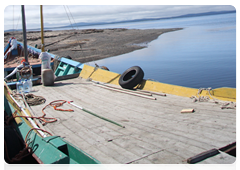MULTIMEDIA
 +
+
Due to recent research, scientists have detected belukha aggregations in Onega Bay and the Kandalaksha Gulf near the Solovetsky Islands, but this whale has not been observed in the White Sea’s Gorlo Strait, the sea’s northern area called the Voronka, and the Dvina Bay
 +
+
Previously, the research mostly aimed at assessing the belukha populations’ sizes for further industrial use. The traditional monitoring methods from ships or aircrafts were used to follow large belukha groups
 +
+
In the past few years, scientists have started observations of belukhas at their population peak in the White Sea, which have become the base for developing the guidelines of the unified aerial survey methods
 +
+
The new approach for aerial survey was developed on the basis of the international experience in cetacean research. According to the research, the summer belukha population in the White Sea totals from 5,500 to 7,500
 +
+
In 2007 and 2008, the genetic and veterinary research of belukhas in the Sakhalin and Amur areas was performed to learn more about the animals’ kinship, as well as possible ways of inhabiting the water and the isolation of belukhas in the Sea of Okhotsk
 +
+
During the International Polar Year of 2007-2008, the researchers launched the Pan-Arctic Tracking of Belukhas program
 +
+
In July and August of 2009, satellite transmitters were attached to two belukha whales named Masha and Dasha on the Chkalov Island. These devices make it possible to track the animals’ movements through the Argos satellite-based system
 +
+
Special radio-frequency identifications with installed data transmitters provide unique information on sea water temperature, salinity, and the direction of ocean currents










 ABOUT THE PROGRAMME
ABOUT THE PROGRAMME
 WHITE WHALE: LIFE, BEHAVIOUR AND MORE
WHITE WHALE: LIFE, BEHAVIOUR AND MORE
 WHITE WHALE RESEARCH: A HISTORY
WHITE WHALE RESEARCH: A HISTORY
 VLADIMIR PUTIN'S VISIT
VLADIMIR PUTIN'S VISIT
 NEWS
NEWS
 MULTIMEDIA
MULTIMEDIA